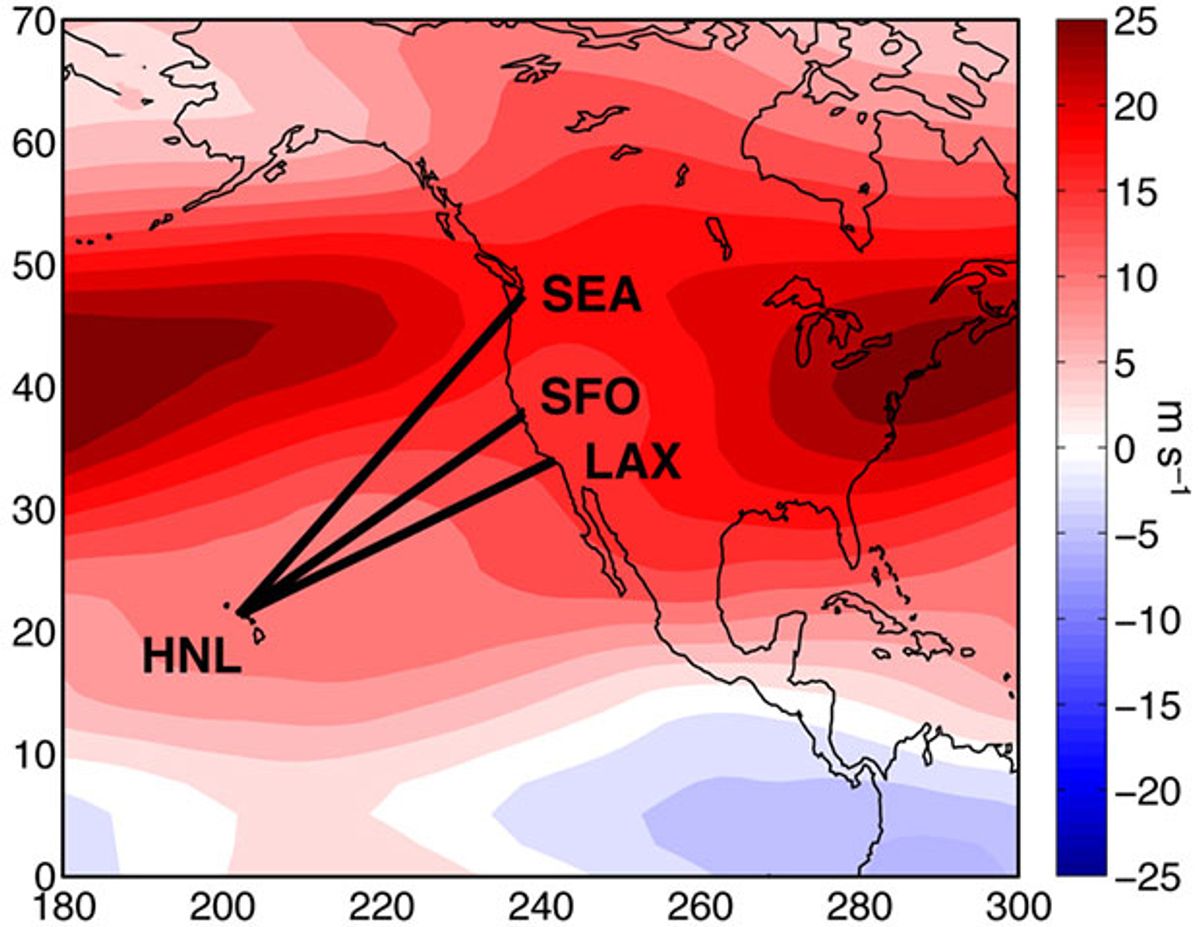Airplanes emit greenhouse gases that cause global warming. Now, a study published in Nature Climate Change suggests that air travel and climate change could actually be coupled in a loop. Changing wind patterns due to a warming climate could lengthen certain flight times, resulting in long-haul flights burning even more fuel and emitting yet more greenhouse gases.
Researchers at the Woods Hole Oceanographic Institution wanted to see how flying times between Hawaii and the western US coast were affected by jet-altitude winds. From a Department of Transportation public database, they got departure and arrival times for every single flight going back and forth between Honolulu and Los Angeles, San Francisco and Seattle for the past 20 years. That was a total of 250,000 flights operated by four major airlines.
Because upper atmosphere winds blow from west to east, eastbound flights are generally faster than westbound ones. The researchers plotted the differences in flight times between eastbound and westbound legs. The graphs were the same for all the airlines. Clearly the same factor was behind the flight time differences over a time scale of many years, says Kristopher Karnauskas, an associate scientist at WHOI. The team hypothesized that long-term climate variability, and not just daily weather, was affecting flight time.
So they dug into data for upper atmosphere winds from the National Oceanic and Atmospheric Administration. They plotted the changes in flight-level wind speeds due to two natural phenomenon that affect global climate—the El Nino Southern Oscillation and the Arctic Oscillation—and overlaid this plot on the flight-time difference plot.

They were surprised to see that both were virtually identical. “It was striking how well correlated they were even when we averaged out the weather, different carriers and climate variables,” Karnauskas says.
Knowing that their hypothesis was right, that climate cycles were affecting flight durations, the team decided to find out how climate change would affect air travel in the future.
By analyzing 34 global climate models, they found that global warming is expected to increase average west-to-east winds. They calculated that such a change would add about 5.5 flying hours to each daily round-trip, per carrier, per route, per year. For all four airlines, that added up to an annual cost of US$1.4 million on fuel and 4.6 million kg of carbon dioxide emissions.
“Although an additional 4.6 million kg CO2 is extremely small compared with the total global emissions by all anthropogenic sources, that calculation is based on only three US domestic routes where zonal wind anomalies have a significant influence,” the researchers write in their paper.
Extrapolating the calculation to the entire global airline industry is not straightforward, Karnauskas says, but the team has taken a stab at a rough estimate. In 2014, there were 102,470 flights per day around the world. If total round-trip flying time changed by one minute on average, commercial jets would be in the air about 300,000 hours longer per year. This would result in about one billion additional gallons of jet fuel burned, costing around US$3 billion and pumping an added 10,000 million kg of carbon dioxide into the atmosphere.
Karnauskas says that the findings could help both the climate scientists and the airline industry. Climate researchers might incorporate this hidden feedback between air travel and climate into current models. “There are no airplanes flying around in climate models,” he says. “There needs to be more work to figure out what the feedback is globally.”
Airlines, meanwhile, could take into account interannual climate predictions such as the ones for El Nino to more accurately predict flight times, manage flight schedules and allocate jet fuel, “giving airlines a competitive edge,” he says. “Those climate predictions are used in sectors like agriculture.”
Prachi Patel is a freelance journalist based in Pittsburgh. She writes about energy, biotechnology, materials science, nanotechnology, and computing.



